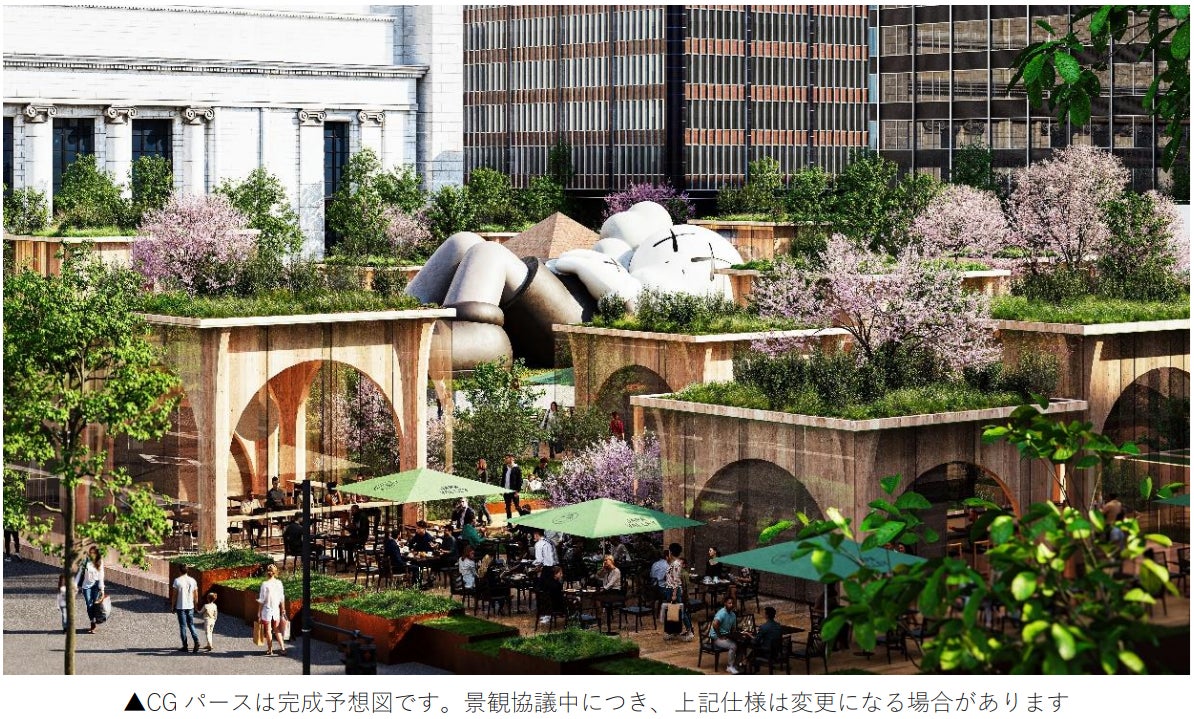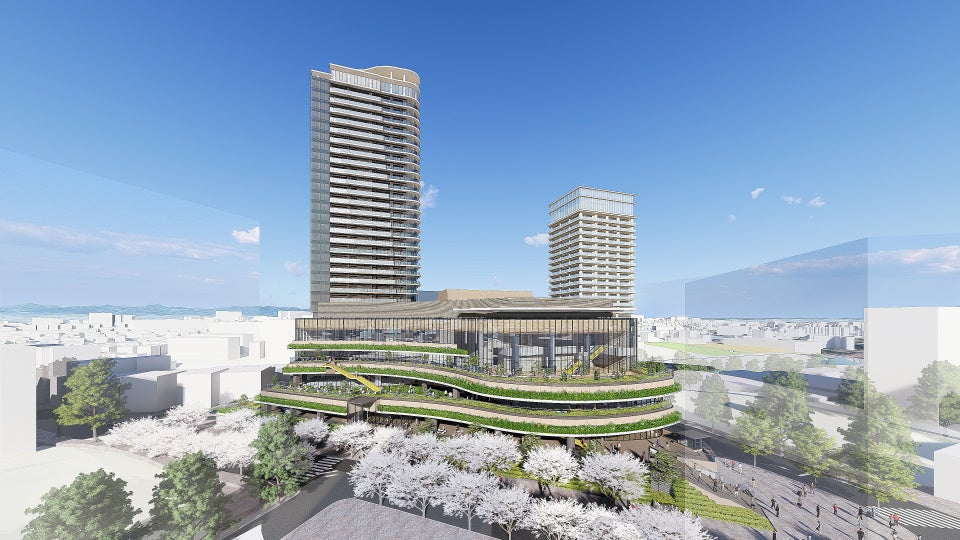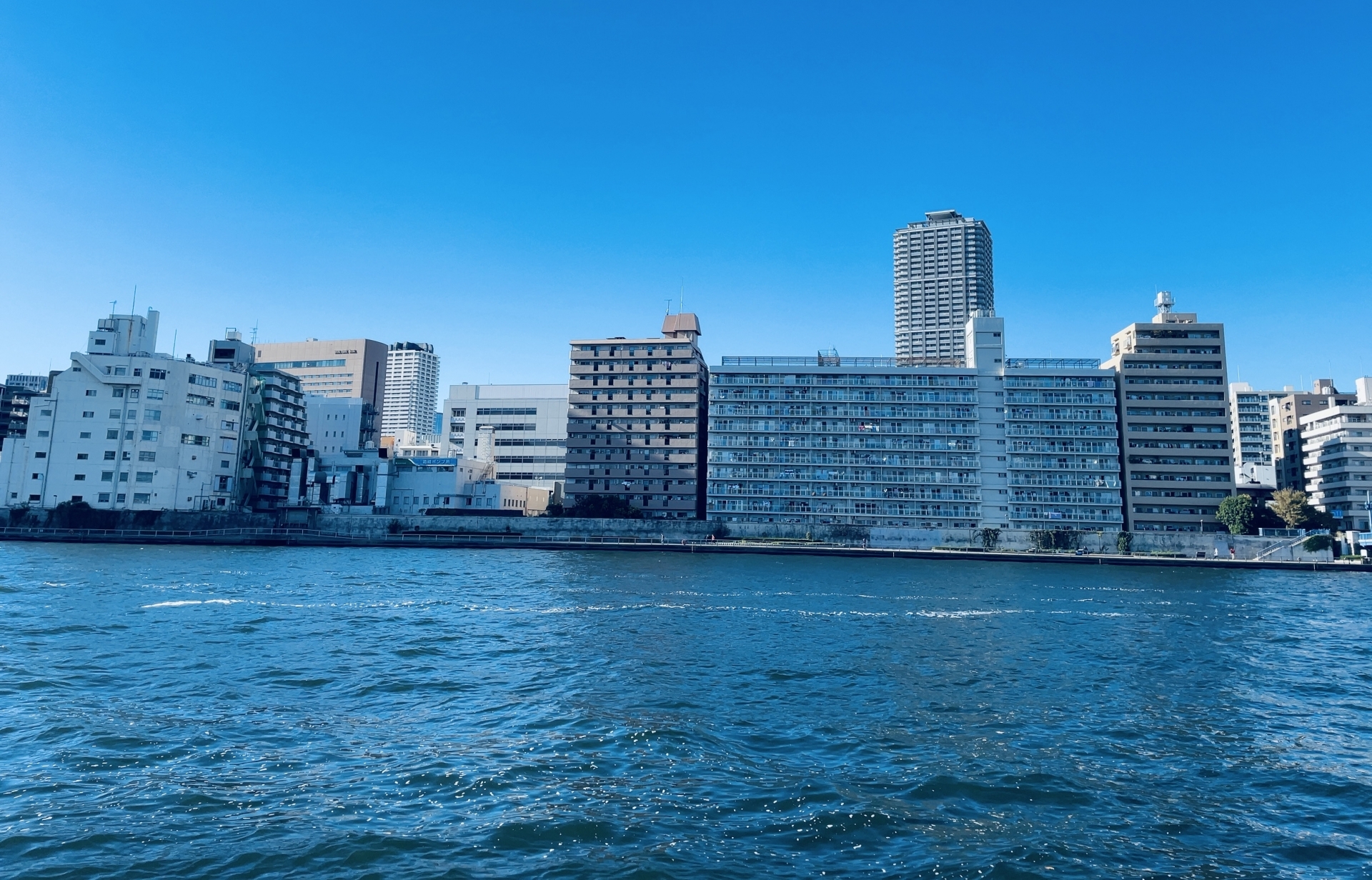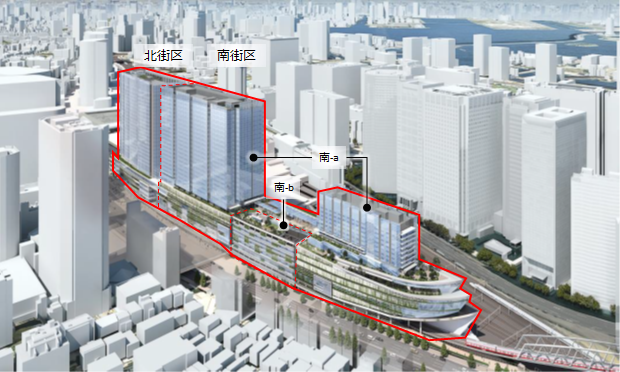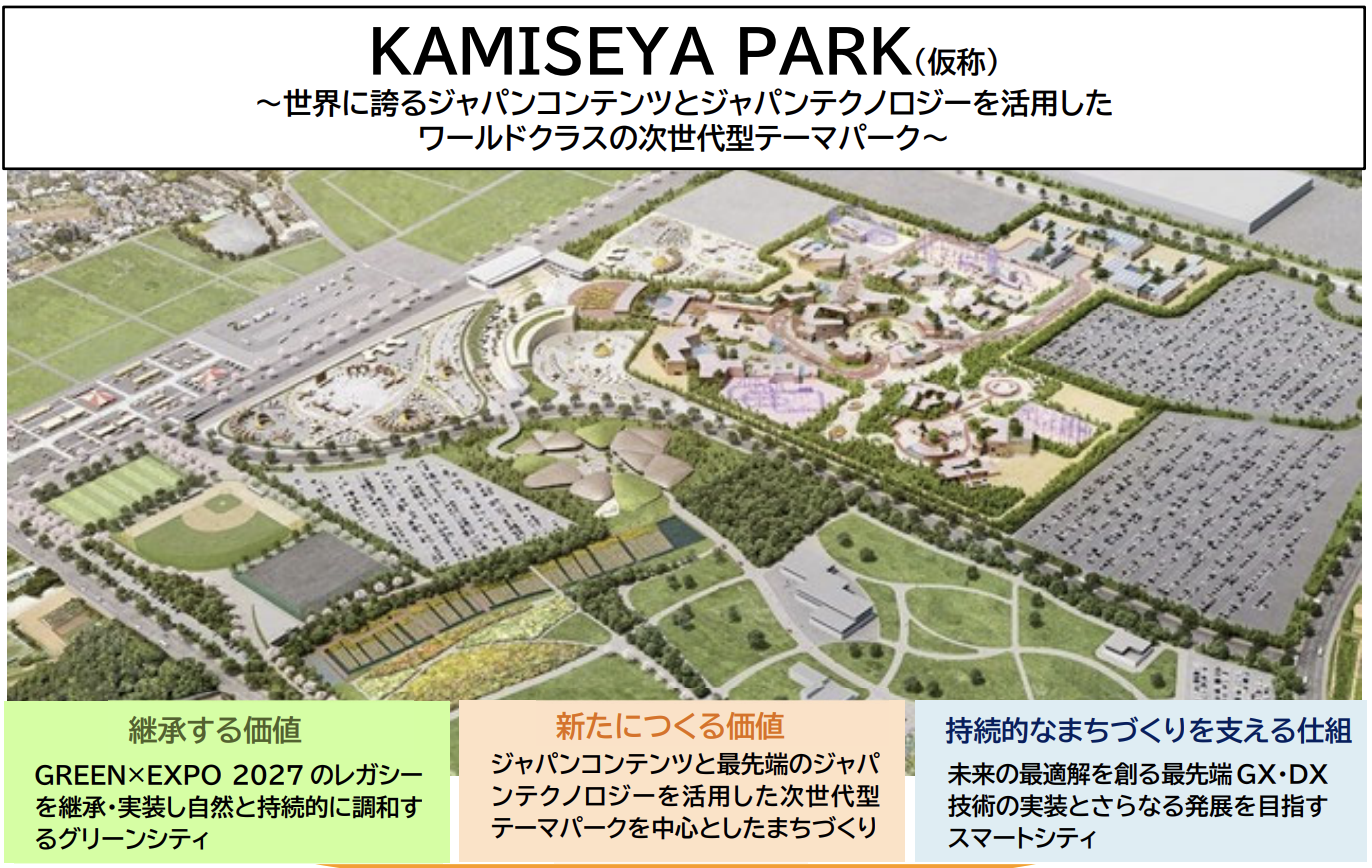The Shirokane-Takana area is located in Minato Ward, central Tokyo, within the Shirokane-Takana district known for its high-end residential neighborhoods. Centered around Shirokane-Takana Station, the starting point of the Tokyo Metro Namboku Line and Toei Mita Line, the area offers a quiet living environment combined with excellent access to the city center. Originally a mixed-use area with factories and wooden houses, the region is undergoing long-term redevelopment and is transforming into one of Tokyo's premier upscale neighborhoods. In recent years, the Shirokane-Takana area has seen a series of large-scale redevelopment projects, which are significantly revitalizing the urban landscape and functions, with a notable impact on property values. In particular, the development around the JR Yamanote Line “Takana Gateway Station,” which opened in 2020, and the “Shirokane 1-chome Western Central Area First-Class Urban Redevelopment Project” are generating significant ripple effects across the entire region, attracting intense interest from affluent individuals and real estate investors both domestically and internationally.
This report provides a detailed overview of the current status of redevelopment in the Shirokane-Takana area as of April 2025, including the impact on real estate values. It covers the area overview and background of redevelopment, major ongoing projects, changes in the cityscape due to redevelopment, specific analyses of the impact on the real estate market, attractions and concerns from the perspective of ultra-high-net-worth individuals and investors, and future prospects and strategic investment considerations.
1. List of ongoing redevelopment projects and overview
Multiple large-scale redevelopment projects are currently underway or recently completed around the Shirokane-Takana Station area, significantly transforming the neighborhood. The major projects are summarized below.
- Takana Gateway Station Area Development (TAKANAWA GATEWAY CITY): This is a large-scale mixed-use development centered around the new JR Yamanote Line station “Takana Gateway Station,” which opened in 2020. The entire area is divided into four districts and being developed in phases. The first district, known as “District 4,” was completed in March 2025. District 4 features two twin towers, “THE LINKPILLAR 1,” with 30 above-ground floors (approximately 158 meters in height) and 29 above-ground floors (approximately 161 meters in height). The lower floors (1–5) will house “Newman Takana,” a commercial facility with approximately 200 stores. Additionally, the upper floors of the North Tower will feature the first JW Marriott Hotel in Tokyo, scheduled to open in autumn 2025. The grand opening, including the remaining 1st to 3rd blocks, is scheduled for spring 2026, with offices, a convention hall, and extensive green spaces (approximately 2.7 hectares of public open space) to be developed sequentially. Through this redevelopment project, which is a major initiative for JR East, the area around Takana Gateway Station is being developed as an “experimental field for enriching life 100 years from now,” aiming to become an international business hub and a next-generation urban development model.
- Shirokane 1-chome Eastern North District Urban Redevelopment Project (SHIROKANE The SKY): This redevelopment project, located a 3-minute walk from Shirokane-Takanawa Station, centers around the “Shirokane The SKY,” a super-high-rise tower apartment building with 45 above-ground floors, 1 underground floor, and a height of approximately 156 meters. The site spans approximately 1.7 hectares and includes the project includes a residential building (East Wing) with 1,247 units, a mid-rise building (West Wing) with 19 above-ground floors, and other structures, integrating residential, industrial, office, and community facilities. The urban plan was approved in July 2013, the redevelopment association was established in April 2015, construction began in August 2019, and the project was completed in February 2023. Shirokane The Sky was completed and began occupancy in 2023, becoming a landmark in the area and a successful example of large-scale redevelopment. New pedestrian decks and walking paths have been added along the nearby Furukawa River, enhancing disaster resilience.
- Shirokane 1-chome Western Central Area First-Class Urban Redevelopment Project: This redevelopment project targets an approximately 1.6-hectare area west of Shirokane-Takana Station and northwest of the Shirokane Shopping District. The project aims to reorganize the densely populated urban area with aging buildings and narrow streets, consolidate land, and improve roads and plazas to create a mixed-use urban area that integrates high-quality residential and commercial functions with the functions of small-scale factories, which are a local industry. The main facilities include a super-high-rise building with 39 above-ground floors and 1 underground floor (approximately 140 meters tall) and a mid-rise building with 14 above-ground floors in Block A, and two low-rise buildings with 4 above-ground floors in Block B, totaling 991 residential units. The participating developers include major companies such as Tokyu Fudosan, Mitsui Fudosan Residential, and Japan Post Real Estate. The development association was established in June 2022, and the land readjustment plan was approved in February 2024. Construction is scheduled to begin in the fiscal year 2025, with completion targeted for the fiscal year 2028. The redevelopment plan includes a large-scale plaza spanning approximately 3,300 square meters, which is expected to serve as a disaster response hub and a new community center for the area.
- Other Related Developments: In addition to the above, the Shirokane-Takana area includes the “Shirokane Ael City” complex, completed around 2005 as part of an existing redevelopment project. This complex consists of the Shirokane Tower (a 42-story residential building) and the NBF Platinum Tower (a 26-story office building). With the infrastructure development around the station already underway, projects in the eastern northern and western central areas are now being implemented in the central part of the area, with the high-density development of the city progressing in stages. Additionally, redevelopment plans are being considered around the Senzaki Temple Station (Tokyo Metro Asakusa Line and Keikyu Line), located between the Takana Gateway Station and Shirokane-Takana Station, further stimulating urban regeneration across the broader Takana area. In terms of road infrastructure, improvements to the local transportation network are also underway, such as the widening of Kitazato Street (announced by the Tokyo Metropolitan Government in 2023), and further improvements to the surrounding environment are expected.
As described above, multiple projects are currently underway in the Shirokane-Takanawa area, ranging from the construction of new railway infrastructure to residential and commercial mixed-use developments, and the overall appearance of the area is undergoing significant changes. In the next chapter, we will delve deeper into the specific changes to the city brought about by these redevelopment projects.
2. Changes to the city due to redevelopment (urban functions, landscape, transportation convenience, etc.)
The redevelopment of the Shirokane-Takanawa area is bringing about changes in various aspects of urban functions, landscape, and transportation convenience. The current situation will be explained below, focusing on the main points.
The construction of super-high-rise towers is transforming the landscape around Shirokane-Takana Station. For example, “Shirokane The Sky” (the high-rise building on the right in the photo), completed in 2023, stands 45 stories tall and has become a new landmark in the Shirokane area, which was previously dominated by low-rise buildings. The mid-rise buildings visible to the left are the west wing of the same project and existing buildings in the surrounding area. Such large-scale redevelopment is modernizing the skyline of the entire area. While the construction of high-rise buildings may affect sunlight and views, the design aims to create a harmonious, upscale streetscape befitting the area's brand image.
In terms of urban functionality, the redevelopment aims to integrate residential and commercial environments. In the redevelopment of the western central area, residential and commercial facilities, childcare and child-rearing support facilities, and the functions of long-established town factories will be appropriately located within the same area, creating a mixed-use town. This will improve the convenience of daily life for local residents and create a lively town throughout the day and night. Additionally, strengthening collaboration with the adjacent Shirogane Shopping District is a priority. New commercial facilities will be connected to existing shopping streets via pedestrian decks and plazas to enhance connectivity and aim for synergistic effects on the local economy. In fact, in the redevelopment of the eastern northern area, public open spaces and pedestrian pathways have been developed, contributing to the strengthening of the pedestrian network along the nearby river. These initiatives are transforming the area from a “city where residential and commercial areas are separated” to a “convenient and vibrant city where living and commerce are integrated.”
Improvements in transportation accessibility are also notable. While Shirokane-Takana Station has always had good access to the city center, the redevelopment has made movement within and outside the area even smoother. In Takana Gateway City, a large pedestrian deck and pedestrian plaza (public realm) directly connected to the station have been developed, creating a 4-hectare walkable space around the station. This public space features abundant greenery (approximately 2.7 hectares), providing an environment where residents can enjoy nature and relaxation despite being in the heart of the city. Additionally, with the opening of the new station, access routes to Shinagawa and Tokyo via the Yamanote Line and Keihin-Tohoku Line have increased, expanding transportation options for residents of the Shirokane-Takana area. In the future, plans are being considered (at the urban planning draft stage) to connect Takanawa Gateway Station with Shirokane-Takanawa Station and Sengakuji Station via a two-story deck and shuttle buses. If the integration of the entire area progresses, the convenience of the railway network will be further enhanced.
Additionally, improvements in disaster resilience and safety are significant changes. Road widening and the creation of new open spaces are being carried out in various redevelopment areas, strengthening disaster infrastructure such as ensuring evacuation routes and forming firebreak zones. In the western central area, a new open space of approximately 3,300 square meters—the largest in the region—is being developed to serve as a temporary shelter and rescue base during disasters. In addition, the replacement of old wooden houses in densely populated areas with earthquake-resistant buildings has dramatically improved earthquake and fire resistance. In the eastern northern district, flood countermeasures have been implemented to prepare for flooding from the Furukawa River, comprehensively improving the safety of the area. In terms of public safety, the increase in people on the streets and the creation of bright pedestrian spaces are expected to improve the crime prevention environment.
As described above, the redevelopment of the Shirokane-Takana area is bringing about qualitative improvements in both the physical and social aspects of the city. While introducing the latest commercial and business functions, the area is also ensuring green spaces and plazas, evolving into an attractive city for residents, workers, and visitors alike. How is this transformation of the city impacting the real estate market? In the next chapter, we will analyze the specific impacts on real estate value, such as land prices, housing prices, and rents, using data.
3. Analysis of Impact on Real Estate Value (Land Prices, Housing Prices, Commercial Real Estate, Rent Trends)
The redevelopment of the Shirokane-Takana area is exerting significant upward pressure on land and real estate values. Here, we analyze the impacts using indicators such as published land prices, housing sales prices, and rent trends.
(1) Land Price Trends: With the progress of redevelopment, land prices in the area have consistently shown an upward trend in recent years. The published land prices in the Minato Ward Takanawa area (including Shirokane-Takana) have increased by approximately 5% annually, surging more than 1.3 times between 2013 and 2018. This momentum has continued unabated, with land prices continuing to rise even during the COVID-19 pandemic since 2020, supported by demand for a return to the city center. In particular, the area around Shirokane-Takana Station has been evaluated for its future potential due to redevelopment, and both residential and commercial areas have recorded high rates of increase. According to the Ministry of Land, Infrastructure, Transport and Tourism's 2024 published land prices, the standard residential land price in Shirokane 1-chome, Minato Ward, increased by approximately +7% year-on-year, reflecting the expectations for redevelopment being factored into prices (specific location data: Minato Ward Shirokane 1-○-○, etc.). This trend is expected to continue into 2025, with experts stating, “The momentum shows no signs of slowing down. With the progress of redevelopment, further increases in land prices are anticipated.” In fact, many real estate developers are actively pursuing land acquisitions in the area, anticipating increased demand in the Shinagawa and Takana districts following the opening of the Takana Gateway Station, and land price increases in the redevelopment areas are likely to continue in the future.
(2) Residential Prices and Asset Value: The effects of redevelopment are also reflected in residential prices. Prices for used apartments around Shirokane-Takana Station have risen significantly over the past decade, with some surveys estimating an average increase of approximately 60–70%. For example, many tower apartments built around 20 years ago within walking distance of the station have seen price increases of several tens of millions of yen compared to a decade ago, resulting in a significant increase in asset value for those who owned them before redevelopment. Additionally, prices for newly constructed condominiums remain at high levels. Shirokane The Sky, for example, was reported to have an average price per square meter (3.3 square meters) of approximately 500–600 million yen at the time of sale, with general residential units in the 70-square-meter range exceeding 1 billion yen. Many units sold out on the first day of sales, reflecting strong demand from affluent buyers. With the redevelopment enhancing the area's brand value, the premium associated with the “Shirokane-Takana” address has grown even stronger among prospective buyers, leading to continued aggressive pricing for both new and used properties. In fact, in the surrounding used condominium market, reference prices for properties near Shirokane-Takana Station have been on an upward trend, with the average price standing at around 58 million yen as of 2023 (for a standard property with a floor area of approximately 60 square meters), marking an increase of over 27% compared to 10 years ago. However, in the most recent period, the rise in interest rates has caused the overall condominium market to cool slightly. Nevertheless, the popularity and scarcity of the Shirokane-Takana area remain unmatched, and the market's expectations for the maintenance and appreciation of asset value in the future remain high.
(3) Commercial Real Estate and Office Market Conditions: The Shirokane-Takana area has traditionally been a residential area with limited large-scale office space. However, with the opening of Takana Gateway City, a new office cluster is beginning to form in the Shinagawa-Takana area. The development boasts a total floor area of approximately 450,000 square meters, with a significant portion of this space being supplied as state-of-the-art office space. This is expected to attract relocation demand from neighboring areas such as the Mita and Tamachi areas, leading to a ripple effect on office rental rates across the entire area. In fact, the Link Pillar Tower, scheduled to open in 2025, will house domestic and international IT companies and startup support facilities (such as the “LiSH” lab, a collaboration between the University of Tokyo and the National University of Singapore), which could further boost demand for residential housing and commercial facilities in the surrounding area by attracting highly skilled talent. Regarding commercial facilities, the Newoman Takanawa (a large-scale commercial mall with approximately 200 stores) is scheduled to fully open in autumn 2025, significantly improving the daily shopping environment for residents of Shirokane-Takanawa. The opening of large-scale commercial facilities will have a ripple effect on surrounding retail stores and service industries, potentially raising tenant rental rates. However, some existing shopping districts may face challenges in attracting customers due to changes in the competitive landscape. Overall, however, the increase in new customer segments is expected to enhance the profitability of commercial areas. Such developments in the commercial environment are likely to drive up the appraisal values of commercial real estate, thereby supporting the overall land prices and property values in the area.
(4) Rent Trends: In the rental market as well, the Shirokane-Takana area is highly popular, with rents on an upward trend. For example, in high-end rental apartments, monthly rents exceeding 300,000 yen for a 2LDK (approximately 70 square meters) are not uncommon, and in high-rise floors of newly constructed tower apartments, premium rents of 500,000 to 600,000 yen per month are being set (as of 2025 market conditions). In particular, after the completion of Shirokane The Sky, a large number of rental units were supplied, but their average asking rents have remained above the surrounding market average. Nevertheless, due to strong demand from affluent individuals and foreign executives who desire to live in “Shirokane,” high-end rentals are being leased relatively quickly, indicating strong absorption capacity in the rental market. With the increased convenience brought by redevelopment, high-income individuals who previously chose other areas such as Azabu-Juban or Hiroo are now beginning to consider Shirokane-Takana, leading to a broader expansion of rental demand. Commercial property rents are also on the rise, with new office floors in the Takana Gateway area being offered at rates comparable to or higher than the Minato Ward average. Depending on market conditions after completion, there is potential upward pressure on rents in existing buildings in the surrounding area as well. Overall, the increase in land and building values due to redevelopment is reflected in rental rates.
Based on the above analysis, it is clear that the real estate value of the Shirokane-Takana area is being significantly boosted by redevelopment, both in terms of land and buildings. Rising land prices reflect expectations for the area's future potential, while increases in housing prices and rents indicate strong demand from both actual buyers and investors. However, there is some caution regarding rapid price increases, and in the next chapter, we will examine the appeal of this area from the perspective of ultra-high-net-worth individuals and investors, along with potential concerns.
4. Attractiveness and concerns of the Shirokane-Takanawa area from the perspective of ultra-high-net-worth individuals and investors
The Shirokane-Takanawa area is an extremely attractive investment and residential destination for ultra-high-net-worth individuals and institutional investors due to its luxurious brand image and growth potential. However, there are also risk factors associated with large-scale development. Here, we will summarize the advantages and concerns from the perspective of high-net-worth individuals and investors.
〈Attractiveness/Positive factors〉
- Brand value and scarcity: As the name “Shirokane” suggests, this area has established itself as one of the most prestigious residential areas in Tokyo. The redevelopment has enhanced convenience and the sophistication of the city, further increasing its brand value. For ultra-high-net-worth individuals, Shirokane-Takana is a safe and secure area to hold assets and a symbol of asset status. In particular, tower mansions directly connected to Shirokane-Takana Station or within walking distance are in limited supply, making them highly sought after by the wealthy as “one-of-a-kind” assets.
- Asset Preservation and Long-Term Stability: Real estate in Tokyo's prime locations tends to maintain its value over the long term, and Shirokane-Takana is expected to see this trend strengthened further due to redevelopment. Real estate, as a tangible asset, has inflation resistance compared to cash or stocks, making it a viable asset preservation tool for the affluent. In fact, cases have emerged where large-scale properties owned by founding families for generations are being traded at high prices. For example, in 2023, it was announced that the former residence of the founder of Seiko (formerly Seikosha) located in Shirokane 2-chome was sold for approximately 30 billion yen, surprising the market. The fact that ultra-high-net-worth individuals are engaging in ultra-high-value transactions in this area provides reassurance to investors.
- Well-developed living convenience and residential comfort: After redevelopment, Shirokane-Takana is evolving into a “city where all aspects of life can be enjoyed in one place, despite being in the heart of the city.” Medical, educational, and shopping environments—crucial for affluent families—are well-equipped with high-quality facilities within the area and in neighboring areas such as Hiroo and Azabu. With the planned opening of the Takanawa Gateway Station, a large green space is set to be created on the site of the former imperial residence in Takanawa, further enhancing the already excellent living environment. For the ultra-wealthy, the living environment is an even more important factor than asset value, and Shirokane-Takana offers an ideal balance of security, privacy, and a harmonious blend of a quiet residential neighborhood and the latest urban amenities.
- Internationality and future growth potential: With its proximity to Shinagawa Station (planned Shinkansen and Linear Station), the area is likely to gain attention as an international business hub in the future. Takanawa Gateway City is also expected to attract foreign companies and startups, and there is a growing demand for housing for foreign executives. Tokyo real estate is popular among wealthy overseas investors due to exchange rate advantages and stable returns, but among these, Shirokane-Takana, which is undergoing rapid redevelopment, is an attractive investment destination for those betting on Tokyo's future potential. The fact that there is still room for further development (e.g., small-scale redevelopment and infrastructure improvements in the surrounding area) makes it easier to envision a long-term growth story, adding to its appeal as an investment target.
〈Concerns and Risk Factors〉
- Risk of oversupply: The simultaneous supply of a large number of apartments in a short period of time could temporarily disrupt the market's supply-demand balance. In fact, with the completion of Shirokane The Sky (1,247 units) in 2023 and an additional 991 units planned for the western central area in the future, there could be a temporary increase in the number of properties available in the used and rental markets. While high-end properties are expected to have strong demand and limited risk of unsold units, in situations where similar properties compete in the same area, there is a risk of slowing asset value growth or stagnating rental rates. However, the likelihood of a prolonged supply surplus is low, and it is generally expected that the surplus will be absorbed in the medium to long term due to the net increase in the urban population and absorption of foreign demand.
- High price levels and interest rate trends: Real estate prices in redevelopment areas are already at fairly high levels. Even for the affluent, there is caution about “buying at high prices” since it is an investment. Looking at the global financial environment, the relative appeal of real estate investment returns has been pointed out as declining amid the recent rise in interest rates. In Japan as well, if there is a shift in monetary easing policy in the future, it cannot be ruled out that downward pressure on real estate prices may arise. Therefore, caution is required in timing purchases and financing strategies, and short-term resale for price gains is considered high-risk. On the other hand, ultra-high-net-worth individuals with ample cash reserves can withstand some market fluctuations as they are focused on long-term holding, but institutional investors need to make cautious decisions, including exit strategies.
- Changes in living environment: While the city is developing, there are concerns about increased noise and congestion due to the growing number of people and vehicles. The traditional image of Shirokane-Takana as a “quiet and sophisticated residential area” may change significantly due to the opening of large commercial facilities and population growth. Some ultra-high-net-worth individuals may move to the suburbs or overseas in search of greater tranquility, making the balance between maintaining the area's appeal a key challenge. However, since the development plans have incorporated the voices of local residents from the outset and taken measures to address noise and landscape concerns, extreme environmental deterioration is expected to be avoided.
- Policy and Regulatory Uncertainty: The real estate market is also influenced by tax and regulatory policies. For example, if property taxes or inheritance taxes are increased in the future, or if regulations on foreign investors are tightened, this could impact the investment mindset of the affluent. Under the current administration, policies supporting urban regeneration (such as relaxation of floor area ratios) are positive factors, but there is still a risk of policy shifts in the long term. However, Shirokane-Takana is not a historically significant area prioritized for preservation in urban planning, and redevelopment is being led by the government, so policy risks are relatively low.
Taking the above into consideration, the Shirokane-Takana area is an “extremely attractive yet requires a cautious approach” market for ultra-high-net-worth individuals and investors. INA also actively recommends this area to clients for asset formation while prioritizing continuous monitoring of market trends and potential risks. The next chapter will present future outlook and strategic real estate investment considerations based on these perspectives.
5. Future Outlook and Strategic Real Estate Investment Considerations
The future outlook for the Shirokane-Takanawa area is bright, with promising investment opportunities expanding. However, considering the risk factors mentioned in the previous chapter, a strategic approach is essential. In this chapter, we will examine the medium- to long-term outlook for the area and discuss prudent real estate investment strategies.
〈Area Future Outlook〉
From 2025 onwards, the Shirokane-Takanawa area will see the completion of a series of redevelopment projects, marking the culmination of urban development in the area. In the spring of 2026, Takanawa Gateway City will open, and will begin full-scale operations as an international business and exchange hub. In the early 2030s, the Linear Central Shinkansen is scheduled to open at Shinagawa Station, which will improve global access and boost the value of the entire Takanawa area. Shirokane-Takana is expected to maintain its unique position as a high-end residential area, leveraging these significant spillover effects while focusing on its excellent living environment. Specifically, to support the increased population resulting from redevelopment, infrastructure improvements in healthcare and education, as well as expanded public services, will be implemented, further enhancing the living environment. The local government (Minato Ward) has designated the Shirokane-Takana area as a “residential promotion zone” in its future population vision, and plans to implement support measures in both soft and hard infrastructure, such as disaster prevention park development and the introduction of housing support for childcare.
Regarding real estate value, it is likely that a steady upward trend will continue in the medium to long term. As long as there is no bubble-like overheating, gradual value appreciation is expected alongside urban growth, and even if there is a temporary adjustment phase due to economic cycles, the area is expected to recover quickly due to its strong location and brand power. Although prices are already high, as mentioned earlier, experts say that now is the best time to buy before prices rise further, indicating that the market still has high expectations for the future. In particular, when the redevelopment of the western central area is completed around 2028-29, the area's completion rate will be extremely high, and some experts point out that the appraisal value may peak at that time. However, on the other hand, a scenario where a new upward trend emerges in the 2030s when the Shinagawa redevelopment and the Linear effect materialize is also anticipated, and the view that “at least a high-level stability over a 10- to 20-year span is expected” is gaining traction.
〈Strategic Real Estate Investment Considerations〉
Based on the above outlook, the following strategies can be considered for real estate investment in the Shirokane-Takana area.
- Long-term holding for capital gains: To benefit from the value appreciation accompanying the area's maturation, a long-term holding strategy is more effective than short-term resale. Targeting price appreciation over a 5- to 10-year span allows for easier absorption of acquisition-related expenses and temporary market fluctuations. Especially for land or single-building investments, long-term holding to benefit from redevelopment gains is a prudent strategy. INA also advises clients that “properties in the Shirokane-Takana area truly realize their full value when held for the long term.”
- Selective investment in high-value-added properties: Even within the area, there are differences in the future value growth potential of individual properties. Specifically, units on the top floors of towers with superior views, floor levels, and brand power, as well as properties with unique features such as direct access to a station or a one-minute walk from a station, are expected to maintain relatively high popularity and value in the future. As an investor, selecting such premium properties, even if they are slightly overpriced, can enhance the quality of your asset portfolio. On the other hand, properties that lack specifications may face the risk of obsolescence in the future, so it is important to carefully assess their acquisition.
- Combining rental operations and sale: When affluent individuals purchase multiple units for investment purposes, a two-pronged strategy of renting them out for income gains (rental income) in the short term and selling them at an opportune time can be considered. Rental demand in the Shirokane-Takana area is robust, and the risk of vacancies is low, making it a stable source of income during the holding period. By selling at a time when capital gains are expected (e.g., immediately after redevelopment is completed and supply and demand are tight), both income and capital gains can be realized. However, when renting out properties, it is important to pay attention to maintenance and tenant management and maintain a management standard commensurate with high-end properties.
- Consider regional and sector diversification: While Shirokane-Takana is promising, appropriate diversification is also necessary within the overall investment portfolio. Within the area, diversifying across sectors such as residential, commercial, and office properties can help offset downturns in one market with gains in others. Additionally, diversifying investments across other areas within Minato Ward (e.g., Toranomon, Azabu) or overseas real estate can help mitigate risks while pursuing return opportunities. At INA, we adjust the investment allocation to Shirokane-Takana based on your risk tolerance to support steady and efficient asset growth.
- Exit strategy considerations: When investing, it is important to consider future exit strategies (such as sale or inheritance). For example, if you plan to sell a property in 10 to 15 years, you should consider in advance whether the property type is likely to attract buyers at that time and what the market cycle is expected to be. In the case of Shirokane-Takana, high-end properties primarily traded among high-net-worth individuals may face limited liquidity, but on the other hand, there is a strong demand base both domestically and internationally, so it is expected that sales may be possible without significant price reductions. In cases of future inheritance, preparation of a tax payment plan is essential if there is a significant gap between the inheritance tax appraisal value and the market price. Given the area's characteristics, where asset sizes tend to be large, succession planning schemes utilizing family offices or asset management companies are also worth considering.
Based on the above strategies, investing in the Shirokane-Takana area requires a long-term, steady, and proactive approach. As Inazawa Daisuke, I will leverage the real estate consulting expertise I have cultivated over the years to support our clients in making the best investment decisions.
6. Conclusion
The Shirokane-Takanawa area is undergoing major transformation due to redevelopment projects currently underway in 2025, which is significantly increasing real estate values in the area. The construction of high-rise tower mansions in front of the station, large-scale development centered on Takanawa Gateway, and the improvement of road and plaza infrastructure are refreshing the city's physical environment, raising the area's potential and bringing about a continuous upward trend in land, housing prices, and rents. Additionally, the area's soft-side appeal—combining the brand value of “Platinum Street” with a green, tranquil living environment despite its central location—has made it popular among a wide range of residents, from ultra-high-net-worth individuals to general family households.
However, rapid changes accompanying redevelopment also pose challenges in terms of supply and demand and the environment. The real estate market requires close monitoring of temporary increases in supply and changes in interest rates, while the local community must address issues arising from rapid population growth. Nevertheless, with the cooperation of Minato Ward, businesses, and residents in advancing sustainable urban development, these concerns will be appropriately managed.
In conclusion, the redevelopment of the Shirokane-Takana area is emerging as a successful model that significantly enhances the value and appeal of the region, making it a highly promising field from a real estate investment perspective. INA will continue to monitor developments in this area, leveraging first-hand information from government agencies and developers, to provide optimal proposals that contribute to our clients' asset formation. As Tokyo's urban regeneration deepens, we are confident that Shirokane-Takana will continue to develop sustainably and that its real estate value will continue to shine brightly into the future.

Daisuke Inazawa
Representative Director of INA&Associates Inc. Based in Osaka, Tokyo, and Kanagawa, he is engaged in real estate sales, leasing, and management. He provides services based on his extensive experience in the real estate industry. Based on the philosophy that “human resources are a company's most important asset,” he places great importance on human resource development. He continues to take on the challenge of creating sustainable corporate value.

.png)

